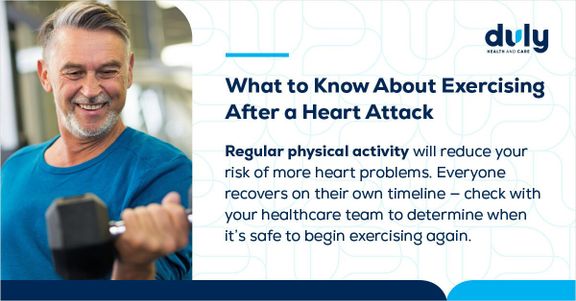If you’ve suffered a heart attack, you know how scary it can be. Moving forward, you’re probably looking for ways to protect your heart from future damage. But fear of further damage may make you hesitant to exercise since it feels like physical activity makes your heart work harder.
However, not only is exercise after a heart attack possible, but it’s also important to reduce your risk for additional problems. Adapting heart-healthy lifestyle choices — including regular physical activity — supports your heart health long-term.

Incorporating regular exercise into your routine after a heart attack might feel overwhelming. It may also be confusing to know what’s safe and what’s not. Here’s why and how you should get moving after experiencing a heart attack.
Exercise After a Heart Attack Can Save Your Life
Heart attack or not, physical activity is a key component of heart health. If you’ve already had a heart attack, it can lower your chances of having another in the future.
Exercise keeps your heart muscle strong, making it more efficient at pumping blood to the rest of your body. It can also widen your capillaries (tiny blood vessels), which allows even more oxygen-rich blood to get to your body.
Regular exercise reduces other risk factors of heart problems by:
- Lowering blood pressure
- Reducing levels of fat in the blood called triglycerides
- Helping you maintain a healthy weight
- Managing your insulin levels and blood sugar (lowering your risk of type 2 diabetes)
- Increasing levels of “good” cholesterol
After a heart attack, you will likely be put on a medication regimen, such as those to lower your blood pressure and lipids. With regular exercise — and with close monitoring from your healthcare provider — you may be able to reduce or even completely stop taking these medications.
The benefits of exercise also extend beyond physical advantages. While heart problems can cause mental health concerns, such as depression and anxiety, the reverse is true, too — exercise can improve your mental health. Physical activity can reduce feelings of depression and anxiety, and it can also improve your quality of life in general.
Quick Tips to Begin Exercising After a Heart Attack
Just as a heart attack is unique to each person, the way you approach physical activity also depends on your individual situation and health needs. This includes how much you exercised before your heart attack and what level of damage your heart muscle suffered.
Before engaging in any exercise after a heart attack, get clearance from your healthcare team that it’s safe to do so. As you begin your exercise journey, always listen to your body — and remember that it could take months to get into a routine that works for you.
If you want to start an exercise routine after a heart attack, make an appointment with a Duly cardiologist to make sure you’re getting moving safely.
Other tips to begin exercising after a heart attack include:
- Try walking, which is easy on the body, as a first activity. When you’ve mastered that, change it up to something else you enjoy, like swimming or biking.
- Start slowly — and increase intensity a little at a time. For instance, begin by walking slowly, then increase your pace gradually every 3 minutes until you’re breathing heavier, but you’re still able to hold a conversation. If you feel short of breath, dial it back a bit.
- Stay close to home. Walk in short distances near your home to avoid difficulty getting back.
- If you experience any concerning symptoms, such as shortness of breath, heart palpitations that won’t go away, fatigue that gets worse over time, or chest pain, stop physical activity, and talk to your healthcare provider.
- If you want to strength train, start slowly, such as doing biceps curls without weights. When that becomes easy, add small weights (or cans of soup). Be sure to ask your healthcare provider before starting strength training after a heart attack.
- Always cool down. Take at least 3 minutes to walk slowly at the end of any exercise.
You may also want to enroll in a cardiac rehabilitation program, where trained professionals will help you work out safely and effectively. They’ll also help you manage other risk factors, such as eating healthy, quitting smoking, losing weight, and managing stress.
No matter your approach, remember that your tolerance for exercise may have changed after a heart attack. Take it day by day, and be patient with your healing body.
Making Exercise a Part of Your Everyday Routine
After a heart attack, you may be looking for new ways to take care of your body. Exercise is one of the best gifts you can give to your body and heart, and it’s never too late to start.
To get the most out of exercise, make sure you get moving most days of the week, if not every day. Even if it’s something small — like walking around the block or swimming laps for 10 minutes — it can have a significant impact on your heart health now and moving forward. Plus, the more you do something, the more it becomes a natural part of your routine.
Your heart may have been through a lot, but it’s still a muscle that needs exercise. Give your heart some extra attention, and your heart will give you what you need for continued health.
Health Topics:

